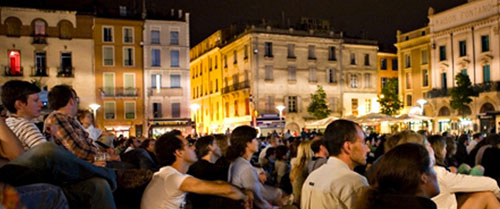American and Chilean photojournalists take top prizes at “Visa pour l’image” photojournalism festival
posted Thursday, September 13, 2012 at 10:53 AM EST
“Visa pour l’image” is the largest exhibition of photojournalism in the world and this year’s top awards went to Chilean photographer Tomas Munita and American Stephanie Sinclair.
Munita received the top award, the ‘Visa d’or’ (Gold medal: daily press photography) for his photography of the effects of war on the lives of ordinary Syrians, while Sinclair received the Arthus-Bertrand ‘Visa d’or’ (best news or feature report) for her portfolio of images of child brides in Afghanistan, India, Nepal, and Nigeria. Sinclair is the first photojournalist to win this prize three times, in 2010 for her series on polygamy in America and in 2004 for images of self-immolation among Afghan women. Despite this recognition, her work is relatively unknown to the public.

Now in its 24th year, the Festival, held in Perpignan, France, is a celebration of the work of the world’s finest photojournalists however, this year there was an especially tragic note to the event. Rémi Ochlik was one of those young photojournalists who went where the action was, whether assigned to it or not. Smuggling himself into Syria, he was at a makeshift pressroom in Homs when it was struck by a government fired missile, killing him and colleagues Gilles Jaquier and Mary Colvin.
Ochlik came from the South of France, and had shown work at Visa several times. To honor him, the Visa awards jury created the “City of Perpignan Rémi Ochlik” award to be given to each year to the “best young photojournalist.”
That is one of the most admirable aspects of “Visa pour l’image” is its openness in seeking out new work and new photojournalists. Any photographer can submit a portfolio at their web site and there is no requirement for affiliation with a press organization. The awards, the recognition, and the cash prizes are all part of Visa’s commitment to helping photographers and to building public awareness of photojournalism.

Perpignan is near the Mediterranean, a few miles from the Spanish border and it is very hot and humid in late August, something I learned, when I exhibited a portfolio there, called, “Too Many Flags” in 2003. A medieval city with narrow, winding streets and a claustrophobic atmosphere; Perpignan is a fittingly appropriate, if troubled setting, for a photojournalism festival. Outside the exhibition halls, neighborhood gangs of Gypsy and North African kids battle over drugs and cigarette smuggling.
In the evenings, Perpignan cools a little. As is the custom in the South, dinners do not begin until 8 PM and after eating Festival attendees will leisurely stroll over to the “Campo Santo,” the former graveyard of the city’s medieval church, outdoor multimedia shows. Projected on huge screens, videos show behind-the-scenes looks at the Festival, interviews with photojournalists, presentations of awards and showings of various participant portfolios.
Overall, while the work presented at Visa is extraordinary, in my experience, few images seem to rise to the level of a Robert Capa or a Don McCullen. Each year, the wars look the same, the pain equally unbearable, but the images blur together.
Several years ago, standing in front of a large color photo of a burning Iraqi tank, a charred body lying across its turret, I was surprised at my response to it “So what.” I thought, “I have seen this image a thousand times before, what am I supposed to make of this one?”
Much of the war photography at Visa can be remote and cold. The photographers record the blood, but sometimes miss the humanity of their subjects. While victims abound, individuals are rare.
Few images have the emotional power of W. Eugene Smith’s work, although Stephanie Sinclair’s “Child Brides” was an exception. Her photographs were both approachable and saddening.
Nonetheless, I believe in the importance of “Visa pour l’image.” It is a bulwark of photojournalism and its support of photographers is inspirational. Personally, I am looking forward to seeing the next Festival next year, Visa’s 25th: blood, warts, and all.
To learn more here’s a video about Visa Pour l’image
Sidebar note: Getty Images awarded $80,000 in grants at the Festival supporting the work of four international photojournalists. Bharat Choudhary, Kosuke Okahara, Paolo Marchetti and Sebastian Liste each received $20,000 prizes and editorial support as winners of the 2012 Getty Grants for Editorial Photography. An additional $20,000 was pledged to the Chris Hondros Fund in order to further support photojournalism and public awareness initiatives through an award given to Andrea Bruce and Dominic Bracco in June.
Read more here.